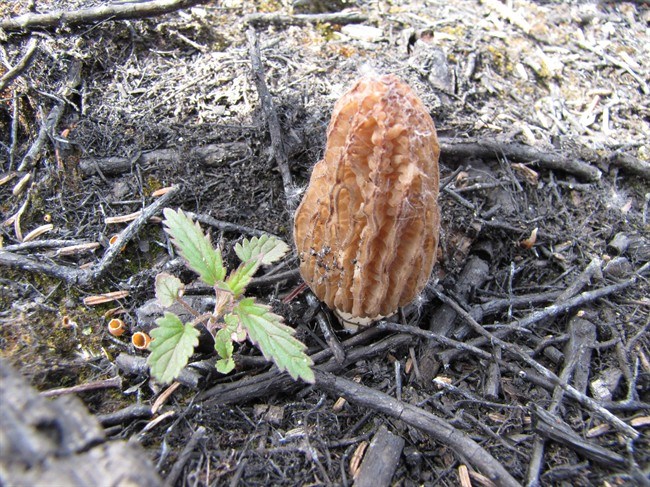
A morel, a type of mushroom, is shown around Sambaa Deh Falls Park in the Dehcho region near Jean Marie River, N.W.T., during the 2014 summer harvest in this undated handout photo. The Northwest Territories government has been promoting the morel harvest for months as a fleeting but lucrative opportunity in the bush, suggesting hundreds of dollars a day are there literally for the picking. Others warn it's a risky venture. THE CANADIAN PRESS/HO - Government of the Northwest Territories
Republished May 28, 2015 - 5:14 AM
Original Publication Date May 28, 2015 - 1:05 AM
Campgrounds are full and cars are lined up along a remote section of highway near Kakisa in the Northwest Territories as residents and southern workers gather for what they hope will be an epic harvest of a rare delicacy — the morel mushroom.
The territorial government has been promoting the harvest for months as a fleeting but lucrative opportunity in the bush, suggesting hundreds of dollars a day are there literally for the picking. Others warn it's a risky venture.
"There are no guarantees," said John Colford of the N.W.T.'s Department of Industry, Trade and Investment. "But if the mushrooms do arrive, there are opportunities."
Rich, earthy-tasting morels, which pop out of soil burned over by forest fires the previous season, are prized by chefs worldwide. The wrinkly, honeycombed fungi are widely picked across North America, but have only recently been harvested in the N.W.T.
After a record 3.4 million hectares of the territory's forest burned in 2014, hopes are high for a bumper yield.
The territory has been working hard to ensure locals get their share of the bounty. Colford organized 19 workshops over the winter in communities throughout the territory's southwest.
Handbooks passed out at information sessions suggest pickers have made anywhere from $200 to $1,000 a day, depending on the going price and how many morels they picked. The territory said the total value of last year's 40-day harvest was between $6 million and $10 million.
This year could easily match that, said Colford. Prices in the field currently sit at around $16 a kilogram.
The action is expected to start over the next week or so, starting in the south and heading north.
Kakisa, a hamlet just south of Great Slave Lake with 45 full-time residents, has more than doubled in size. The community has already held a cookout to welcome out-of-towners, said Chief Lloyd Chicot.
"We want to welcome them and, at the same time, address some of the community concerns," he said. "It's turned out really nice.
"There's people coming in steady."
Chicot said plenty of local people are likely to join the visitors in the pick.
"There's been interest here since the early winter. There's a few of us going out to see what it's like."
What it's like is hot, dirty, buggy and swampy, said Dylan Gordon, a University of Toronto anthropologist who's writing his thesis on wild food harvesters.
"You do a lot of walking — 20, 30 kilometres a day through the bush."
The money is uncertain. If there's no rain, the mushrooms don't show. If there's too much, oversupply depresses prices.
Gordon estimates he made about $100 a day harvesting in 2012 — a poor year.
But it's not all about the money. Mushrooms can give northern families a chance to get out on the land together.
"They'll set up a camp, the elders can pick, the kids pick, the whole family gets together and a lot of people say it's good for them," Gordon said.
"It draws people back to the land who aren't always as engaged with it as maybe they would like to be or used to be."
All the pickers need now is rain, said Colford. The N.W.T. is in the middle of a multi-year drought and hype over this year's boreal bonanza may come to naught if the mushrooms don't get the moisture they need to sprout.
"Mother Nature has a huge role to play," he said. "But if we get a warm, damp summer, the potential is massive.
"If we get a typical northern summer, we'll see a very busy June."
News from © The Canadian Press, 2015